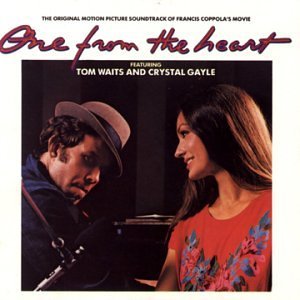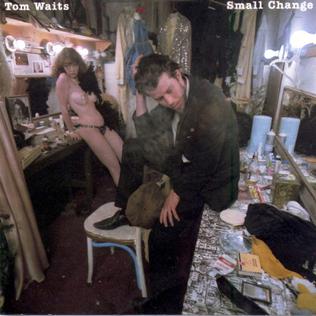Related Research Articles

Thomas Alan Waits is an American musician, composer, songwriter and actor. His lyrics often focus on the underbelly of society and are delivered in his trademark deep, gravelly voice. He worked primarily in jazz during the 1970s, but his music since the 1980s has reflected greater influence from blues, rock, vaudeville, and experimental genres.

Hal Blaine was an American drummer and session musician, thought to be among the most recorded studio drummers in the music industry, claiming over 35,000 sessions and 6,000 singles. His drumming is featured on 150 US top 10 hits, 40 of which went to number one.

One from the Heart is a soundtrack album of Tom Waits compositions for the Francis Ford Coppola film of the same name. It was recorded from October 1980 to September 1981. It was during this period that Waits met his wife Kathleen Brennan, an employee at the studio where it was recorded. While the film was released in February, the soundtrack album release was delayed until October of 1982 due to a dispute between Columbia Records and Coppola's Zoetrope Studios.

Blue Valentine is the sixth studio album by singer and songwriter Tom Waits, released on September 5, 1978 on Asylum Records. It was recorded over the course of six sessions from July to August 1978 with producer Bones Howe. Rickie Lee Jones is pictured with Waits on the back cover.

Small Change is the fourth studio album by singer and songwriter Tom Waits, released on September 21, 1976 on Asylum Records. It was recorded in July at Wally Heider's Studio 3 in Hollywood. It was successful commercially and outsold his previous albums. This resulted in Waits putting together a touring band - The Nocturnal Emissions, which consisted of Frank Vicari on tenor saxophone, FitzGerald Jenkins on bass guitar and Chip White on drums and vibraphone. The Nocturnal Emissions toured Europe and the United States extensively from October 1976 till May 1977.

The Heart of Saturday Night is the second studio album by singer and songwriter Tom Waits, released on October 15, 1974, on Asylum Records. The title song was written as a tribute to Jack Kerouac. The album marks the start of a decade-long collaboration between Waits and Bones Howe, who produced and engineered all Waits' recordings until the artist left Asylum.

Nighthawks at the Diner is the third studio album by singer and songwriter Tom Waits, released on October 21, 1975 on Asylum Records. It was recorded over four sessions in July in the Los Angeles Record Plant studio in front of a small invited audience set up to recreate the atmosphere of a jazz club. The album peaked at 164 on the Billboard 200, the highest place Waits had held at the time, and is currently certified silver by the BPI. It has received critical acclaim for its successful mood-setting, capturing of the jazz-club atmosphere and characterization.

Bone Machine is the eleventh studio album by American singer and musician Tom Waits, released by Island Records on September 8, 1992. It won a Grammy Award for Best Alternative Music Album and features guest appearances by David Hidalgo, Les Claypool, Brain, and Keith Richards. The album marked Waits' return to studio albums, coming five years after his previous effort Franks Wild Years (1987).
Lincoln Wayne "Chips" Moman was an American record producer, guitarist, and songwriter. He is known for working in R&B, pop music and country music, operating American Sound Studios and producing hit albums like Elvis Presley's 1969 From Elvis in Memphis and the 1985 debut album for The Highwaymen. Moman won a Grammy Award for co-writing "(Hey Won't You Play) Another Somebody Done Somebody Wrong Song", a 1976 hit for B.J. Thomas.
United Western Recorders was a two-building recording studio complex in Hollywood that was one of the most successful independent recording studios of the 1960s. The complex merged neighboring studios United Recording Corp. on 6050 Sunset Boulevard and Western Studio on 6000 Sunset Boulevard.

Singer Presents ... Elvis, commonly referred to as the '68 Comeback Special, was a televised concert of American singer Elvis Presley which aired by NBC on December 3, 1968. It marked Presley's return to live performance after seven years during which time his career was centered on the film industry. Presley was unhappy with his distance from musical trends of the time, and the low-quality film productions in which he was involved.
Gems is a compilation album released by Aerosmith in 1988 under the label Columbia. It was the first compilation of studio material since 1980's Greatest Hits. Concentrating mainly on heavier material than the radio-friendly singles output on Greatest Hits, the album is noted for the inclusion of the 1978 studio version of "Chip Away The Stone" – previously released as a single from 1978's Live! Bootleg, only a live rendition of the song was released at the time. Originally scheduled for release on November 8, 1988, the album was delayed one week and issued on November 15, 1988.

Peter Michael Thomas is an English rock drummer best known for his collaboration with singer Elvis Costello, both as a member of his band the Attractions and with Costello as a solo artist. Besides his lengthy career as a studio musician and touring drummer, he has been a member of the band Squeeze during the 1990s and a member of the supergroup Works Progress Administration during the early 2000s.
Tchad Blake is an American record producer, audio engineer, mixer and musician.

Broken Blossom is the fourth studio album by American singer Bette Midler, her second album release in 1977 and her fifth on the Atlantic Records label. Just as Midler's three previous studio albums Broken Blossom includes songs from a wide variety of genres, ranging from Edith Piaf's signature tune "La vie en rose", Phil Spector-esque covers of Billy Joel's "Say Goodbye to Hollywood" and Harry Nilsson's "Paradise" and hard rock like Sammy Hagar's "Red", to a jazzy duet with Tom Waits, "I Never Talk to Strangers", and a rendition of "A Dream Is a Wish Your Heart Makes", originally from Walt Disney's 1950 film version of Cinderella. The album reached #51 on Billboard's album chart.

From Elvis in Memphis is the tenth studio album by American rock and roll singer Elvis Presley. It was released by RCA Records on June 17, 1969. It was recorded at American Sound Studio in Memphis in January and February 1969 under the direction of producer Chips Moman and backed by its house band, informally known as "The Memphis Boys". Following the success of Presley's TV special Elvis and its soundtrack, the album marked Presley's return to non-soundtrack albums after the completion of his film contract with Paramount Pictures.

Love Among the Cannibals is the third album released in 1989 by rock band Starship. It was the first album after Grace Slick's departure from the band, and their last full-length studio release until Loveless Fascination in 2013. The album marks a shift in the band's musical direction, featuring a harder edged, AOR style as opposed to the synth pop of their first two albums. Another departure from the preceding albums is the decrease in outside writers, as this album features four songs written by Thomas, Morgan, or Chaquico. The song "Wild Again" had previously been produced for the soundtrack to Cocktail (1988), and was included as a bonus track for the album's CD release. The album had one top 20 single on the Billboard charts, "It's Not Enough", which peaked at No. 12 in October 1989 and was their final Top-40 hit, but the album itself only climbed to No. 64. The track "I'll Be There" went on to being featured in the end credits of Gross Anatomy (1989).

Elvis Is Back! is the fourth studio album by American rock and roll singer Elvis Presley, released on April 8, 1960 by RCA Victor. It was Presley's first album released in stereo. Recorded over two sessions in March and April, the album marked Presley's return to recording after his discharge from the U.S. Army. It was Presley's first album of new material since Elvis' Christmas Album was issued in 1957.
Jacquire King is an American record producer, recording engineer and mixer. King has worked with such notable artists as Kings of Leon, Tom Waits, James Bay, Kaleo, Modest Mouse, Shania Twain, Buddy Guy, Norah Jones, Of Monsters and Men, Cold War Kids, Punch Brothers, City and Colour, Robert Ellis, Dawes and others. His work has received more than 35 Grammy Award nominations to date.

Stacy Parrish, and raised in Albuquerque, New Mexico, is an American songwriter, musician, engineer, and record producer.
References
- ↑ "Tom Waits Albums from Worst to Best". 9 September 2013.
- ↑ "The 10 Best Tom Waits Albums to Own on Vinyl". 2 August 2016.
- ↑ Daley, Dan (February 2004). "'Bones' Howe & Tom Waits". Sound On Sound. SOS Publications Group. Retrieved 1 April 2022.
- ↑ Coffee, Hoyt (Summer 1998). "Bones Howe". Georgia Tech Alumni Magazine. Georgia Tech Alumni Association. 75 (1). ISSN 1061-9747. Archived from the original on 2002-12-11. Retrieved 2015-10-29.
- ↑ Vdovin, Marsha. "UA Heritage: Engineer/Producer Bones Howe Remembers His Days at United/Western Working with the First 1176 Prototype". uaudio.com. Universal Audio. Retrieved 4 April 2022.
- ↑ Cogan, Jim; Clark, William (2003). Temples of Sound: Inside the Great Recording Studios. San Francisco, California, United States: Chronicle Books. p. 38. ISBN 0-8118-3394-1.
- ↑ Hogan, Ed. "Bones Howe Biography". Allmusic . Rovi Corporation . Retrieved 18 March 2014.
- ↑ "Bones Howe | Biography & History".